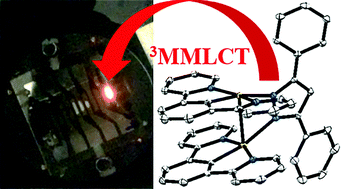Luminescent properties of a 3,5-diphenylpyrazole bridged Pt(ii) dimer†
Abstract
We report the synthesis, electrochemistry, photophysical properties and electroluminescence of a highly luminescent pyrazolate-bridged platinum(II) complex. The complex has the general formula of [((N^C^N)Pt)2(μ-pz)][PF6] where N^C^N = 1,3-di(2-pyridyl)benzene and μ-pz = 3,5-diphenylpyrazolate. The X-ray structure shows that the bridging pyrazolate ligand causes a close Pt–Pt interaction of 3.05(7) Å. The emission profile of the complex was determined in solution, glassy 2-methyltetrahydrofurane at 77 K, and the solid state at both room temperature and 77 K. Each emission profile displayed a strong red metal–metal-to-ligand charge transfer while the solution and glassy 2-methyltetrahydrofurane emission profiles also displayed a ligand-centred transition. The absolute quantum yields of the complex in solution and the solid state at room temperate are 86% and 39%, respectively. Light-emitting electrochemical cells (LEECs) of [((N^C^N)Pt)2(μ-pz)][PF6] were fabricated which displayed appreciable electroluminescence, among the brightest and most efficient LEECs from dinuclear compounds to date.

- This article is part of the themed collection: The central role of the d-block metals in the periodic table


 Please wait while we load your content...
Please wait while we load your content...
